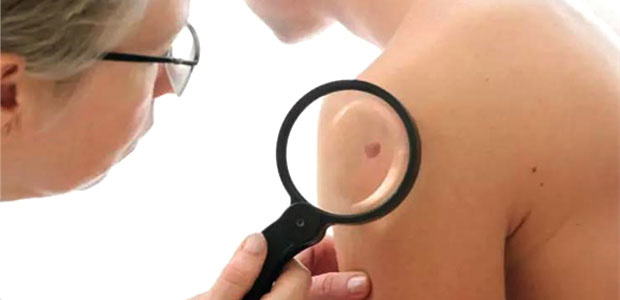
What is Skin Cancer?
The skin protects our body against heat, light, infection and injury. It also stores water, fat and vitamin D. It is made up of three distinct layers: the epidermis, the dermis and the hypodermis. Skin cancer is a disease in which cancer cells are found in the outer layers of the skin. Under normal circumstances, skin cells operate in an orderly manner to maintain tissue health. A cellular mass or tumor forms when growth control is lost. Most skin tumors are benign and are not likely to turn cancerous. However, if the tumor spreads to surrounding tissues or organs, it is considered malignant, or cancerous.
There are many types of skin cancers but the three most common ones are:
Basal cell carcinoma (60%): This is a slow-growing painless skin cancer. The cancer often presents as an indolent ulcer with a shiny or translucent raised margin. The ulcer is often pigmented. This cancer commonly appears on the face.
Squamous cell carcinoma (34%).This presents as a firm irregular fleshy growth, usually on sun-exposed skin. The growth can increase rapidly in size giving rise to a large lump, which may sometimes break down to form an ulcer. If untreated, the cancer may spread to the surrounding lymph glands. Squamous cell carcinoma usually appears in elderly patients. Chronic sun exposure is an important contributing factor in the development of this skin cancer.
Malignant melanoma (4%) This is a cancer of the pigment cells of the skin. It is a highly malignant skin cancer. It presents as a dark brown or dark skin growth or ulcer. It may look like an ordinary mole. But unlike the common mole
– it grows rapidly
– it has an irregular margin
– it tends to be large
– it tends to be thick
– its surface has several shades of red, black or blue colors.
It occurs on fingers, toes and face.
Are you at risk?
Common skin cancer seems to be related to a slow build- up of the effects of exposure to the sun’s ultraviolet rays over many years. Although anyone can get skin cancer, people with certain characteristics are particularly at risk. These include:
Fair to light-skinned people who do not tan but go red in sun
People with red hair & blue eyes
Family history of skin cancer
Personal history of skin cancer
Chronic exposure to the sun
History of sunburn early in life
People with atypical moles
People with freckles and/or a large number of moles
The risk may also increase if one is on certain drugs, or under ultraviolet therapy, or exposed to certain industrial chemicals.
How to prevent?
Exposure to the sun’s ultraviolet (UV) rays appears to be the most important factor in the development of skin cancer. Skin cancer is largely preventable when sun protection measures are consistently used. Follow these "safe-sun" guidelines whenever you are in the sun:
Reduce sun exposure, if you can, especially from 10am to 4pm when the sun’s UV ray are the most intense or when the UV index is 3 or more.
Wear a long-sleeved shirt and long pants to protect the skin. Loose-fitting and cotton clothing are cooler.
Wear sunglasses to protect your eyes from the sun. Sun exposure increases your risk of getting cataracts.
Wear a wide-brimmed hat. Wide-brimmed hats help protect your face, neck and ears from the sun.
Use a sunscreen with a sun protection factor (SPF) of at least 15 daily, even on cloudy days.
Remember about reflection: Water, sand, snow and concrete can reflect up to 80% of the sun’s damaging rays.
Avoid tanning salons and sunlamps: These lights emit mostly UVA radiation – up to 2 – 5 times as much as natural sunlight. UVA radiation cause sunburn, premature aging of the skin and skin cancer.
What are the signs and symptoms?
 viber
viber